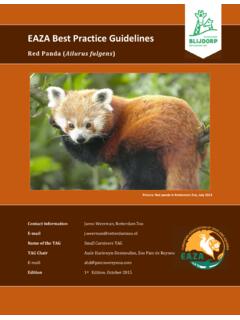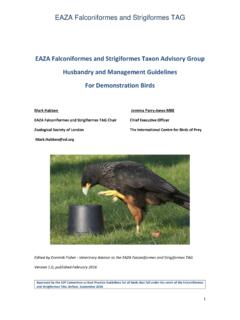Transcription of EAZA Best Practice Guidelines for the white rhinoceros
1 1 eaza best Practice Guidelines for the white rhinoceros eaza best Practice Guidelines for the white rhinoceros (Ceratotherium Simum) 2018 First Edition, July 2018 | Lars Versteege 2 eaza best Practice Guidelines for the white rhinoceros (Ceratotherium simum) Editor: Lars Versteege Contact information: Safaripark Beekse Bergen, Beekse Bergen 31, 5081 NJ Hilvarenbeek, The Netherlands Email: Name of TAG: Rhino TAG TAG Chair: Friederike von Houwald (Zoo Basel, Switzerland) Edition: 1 July 2018 3 eaza best Practice Guidelines Disclaimer Copyright (March 2018) by eaza Executive Office, Amsterdam.
2 All rights reserved. No part of this publication may be reproduced in hard copy, machine-readable or other forms without advance written permission from the European Association of Zoos and Aquaria ( eaza ). Members of the eaza may copy this information for their own use as needed. The information contained in these eaza best Practice Guidelines has been obtained from numerous sources believed to be reliable. eaza and the eaza Felid TAG make a diligent effort to provide a complete and accurate representation of the data in its reports, publications and services.
3 However, eaza does not guarantee the accuracy, adequacy or completeness of any information. eaza disclaims all liability for errors or omissions that may exist and shall not be liable for any incidental, consequential or other damages (whether resulting from negligence or otherwise) including, without limitation, exemplary damages or lost profits arising out of or in connection with the use of this publication. Because the technical information provided in the eaza best Practice Guidelines can easily be misread or misinterpreted unless properly analyzed, eaza strongly recommends that users of this information consult with the editors in all matters related to data analysis and interpretation.
4 4 Preamble Right from the very beginning it has been the concern of eaza and the EEPs to encourage and promote the highest possible standards for husbandry of zoo and aquarium animals. For this reason, quite early on, eaza developed the Minimum standards for the accommodation and Care of Animals in Zoos and Aquaria . These standards lay down general principles of animal keeping, to which the members of eaza feel themselves committed. Above and beyond this, some countries have defined regulatory minimum standards for the keeping of individual species regarding the size and furnishings of enclosures etc.
5 , which, according to the opinion of authors, should definitely be fulfilled before allowing such animals to be kept within the area of the jurisdiction of those countries. These minimum standards are intended to determine the borderline of acceptable animal welfare. It is not permitted to fall short of these standards . How difficult it is to determine the standards , however, can be seen in the fact that minimum standards vary from country to country. Above and beyond this, specialists of the EEPs and TAGs have undertaken the considerable task of laying down Guidelines for keeping individual animal species.
6 Whilst some aspects of husbandry reported in the Guidelines will define minimum standards , in general, these Guidelines are not to be understood as minimum requirements; they represent best Practice . As such the eaza best Practice Guidelines for keeping animals intend rather to describe the desirable design of enclosures and prerequisites for animal keeping that are, according to the present state of knowledge, considered as being optimal for each species. They intend above all to indicate how enclosures should be designed and what conditions should be fulfilled for the optimal care of individual species.
7 Citation This publication should be cited as follows: eaza white rhino EEP best Practice Guidelines ; L. Versteege; Safaripark Beekse Bergen; July 2018 Summary The best Practice Guidelines , designed as reference manual for any professional working with white rhino are divided into two sections. Section one describes the natural biology of the white rhino whereas section two describes the best Practice husbandry in captive settings. Chapters include enclosure design, nutrition, social structure, breeding, handling and veterinary care. 5 Contents eaza best Practice Guidelines Disclaimer.
8 3 Preamble .. 4 Citation .. 4 Summary .. 4 List of figures .. 8 List of tables .. 9 1. Introduction .. 10 Section 1 - Biology and field data .. 11 Biology .. 11 Taxonomy .. 11 Morphology .. 11 Physiology .. 12 Longevity .. 12 Field data .. 13 Geography and Ecology .. 13 Diet and feeding behaviour .. 15 Reproduction .. 15 Behaviour .. 16 Section 2 - Management in zoos .. 17 Enclosure .. 17 Dimensions .. 17 Boundary .. 17 Drive-through enclosure .. 22 Substrate .. 22 Furnishings and maintenance .. 23 Environment.
9 25 Feeding .. 26 Basic diet .. 26 Special dietary requirements .. 28 Method of feeding .. 29 Water requirements .. 29 Social structure .. 30 6 Basic social structure .. 30 Changing group structures .. 30 Sharing enclosure with other species .. 32 Breeding .. 33 Mating .. 33 Pregnancy .. 33 Contraception .. 34 Birth .. 34 Development and care of young .. 35 Hand-rearing .. 36 Population management .. 36 Behavioural enrichment .. 37 Rhino behaviour .. 37 Types of enrichment .. 38 Implementation .. 40 41 Individual identification and sexing.
10 41 General handling .. 41 Catching/restraining .. 41 Transport .. 42 Safety .. 44 Veterinary .. 45 eaza Bio Bank .. 45 Foot problems .. 45 Skin problems .. 46 Parasites .. 46 Bacterial infections .. 47 Viral diseases .. 48 Reproductive disorders .. 48 Mortality .. 49 Diet .. 49 Anaesthetics .. 49 Specific problems .. 51 Recommended research .. 51 7 3. Discussion .. 52 4. References .. 53 Books .. 53 Journals .. 54 Electronic sources .. 57 Unpublished Works .. 58 Pictures .. 59 Appendix I: eaza standards .





